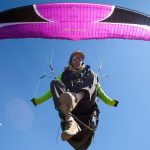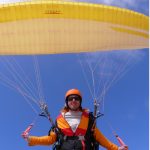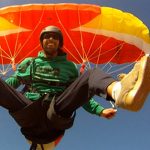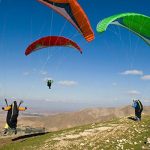A bit of history about paragliding
The 70's were years of great diffusion of hang gliders and base jumping (from cliffs) by parachutes. In 1972 the members of the skydiving club of Annemasse, in Haute Savoie (France), decided to use the drawer parachute (designed by NASA in 1965 and first used in the French World Championship in 1969 by the American team), taking off on foot from the slopes (skydiving descent - paragliding) and thus eliminating the plane forever.
The first paraglider pilots
The first to launch was Claude Bétemps and Gérard Bosson, who made their first flights in Mieussy (France). Very shortly afterwards it flies the same way in Chamonix, in Geneva and progressively in all the main flight centres of Europe.
The evolution of the designs of the canopies and the performance in flight made many mountaineers felt interested in a new way to descend from the summits of the mountains after their climbings. The first of these dates from 1982 toke off near the Montblanc to land a few minutes later on the Chamonix meadows. Practitioners continued increasing and with them, unfortunately, also accidents. But everything evolves, and over the years accidents are decreased and new professional paragliding schools were created.
Nowadays, paragliding is one of the most popular aerial sports, with millions of pilots all around the World.
Why do you want to fly?
In most of the sports, it is not necessary for the beginner to have any previous experience. But, although it is not necessary to have any technical knowledge, it is necessary that you know something about yourself and why you want to fly with a paraglider. If you want to fly to demonstrate that you are not afraid of danger, or to show your friends that you are capable of doing it, or even just because you are envious of the birds, don't do it.
The free flight is an aerial sport only for those who really want to fly, who are willing to start from the beginning, to accept the teachings and advice of the instructors and experienced pilots, respect the elements, take proper care of your equipment, be always willing to help and collaborate with other pilots and, above all these things, be
aware of their own limitations.
The spectacle of birds soaring through the skies or waving its powerful wings over the storm-beaten cliffs in winter has always attracted to humans. Some people feel attracted because it is beautiful, but others because it involves a personal challenge: the desire to fly like and with those birds, alone, in the blue sky.
It is not enough for these people to fly in a closed plane; it doesn't even satisfy the need to soar through the clouds in an elegant and sophisticated glider. It is the freedom and independence of birds which attracts so many people of all ages to this exciting aerial sport: paragliding.
The desire to fly like birds is not new, of course. People have been building wings from the famous Icarus of Greek mythology, who fell into the sea for not carry out an adequate pre-flight inspection, do not measure its limitations and not to pay attention to Daedalus. His catastrophe has been famous ever since, while Daedalus, who apparently succeeded, has never made headlines.
Learn to paraglide
If you really want to learn to fly you should find a certified paragliding school, with a good reputation and professional instructors who teach you with guarantees of good quality and safely.
Like many outdoor sports, Paragliding is weather dependent activity and this will affect the quality and the time you have to spend on your training. Many students can feel frustrated if their paragliding course takes too long due to the bad weather every weekend they go to school. So, take in to account this when you choose the school: often it is worth to do your course in a place where the weather is good and you can do your paragliding course in just a couple of weeks and not spend more time, money and enthusiasm trying to learn in a place where rains every time you could fly.
If you have more questions about paragliding you can find the answers in our FAQ section.
(Traducido del "Manual Básico del Parapentista" de Guillermo Alberto Saez).
















